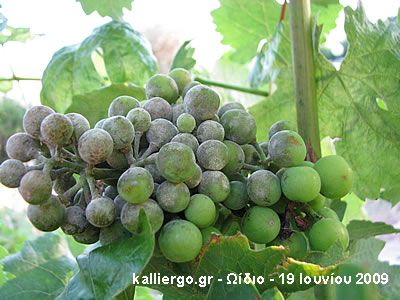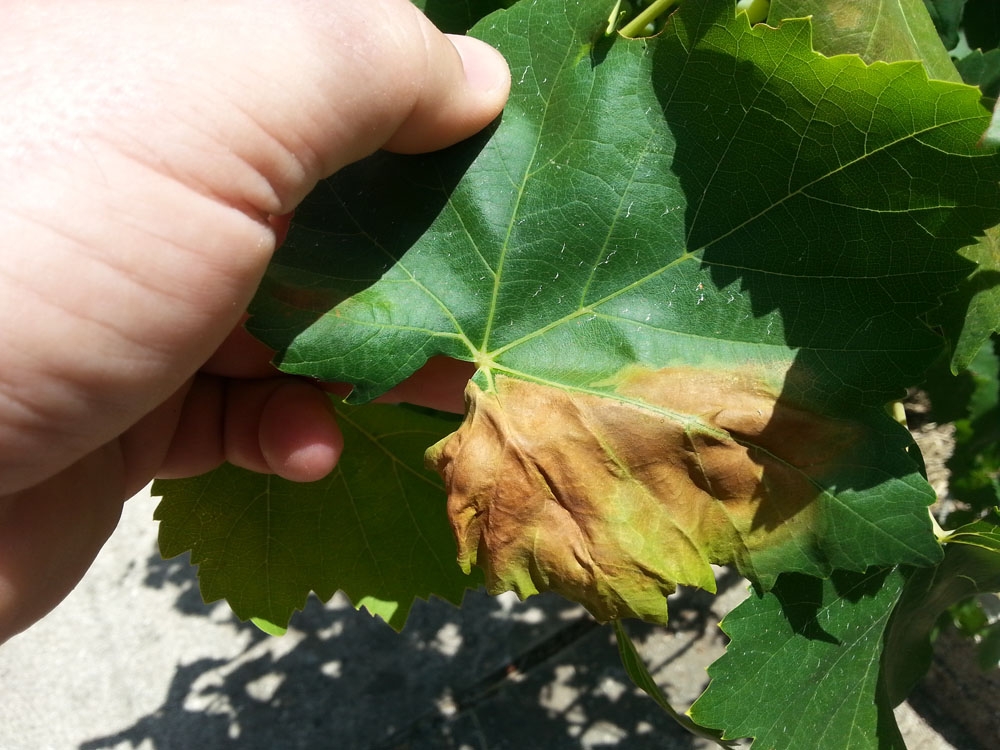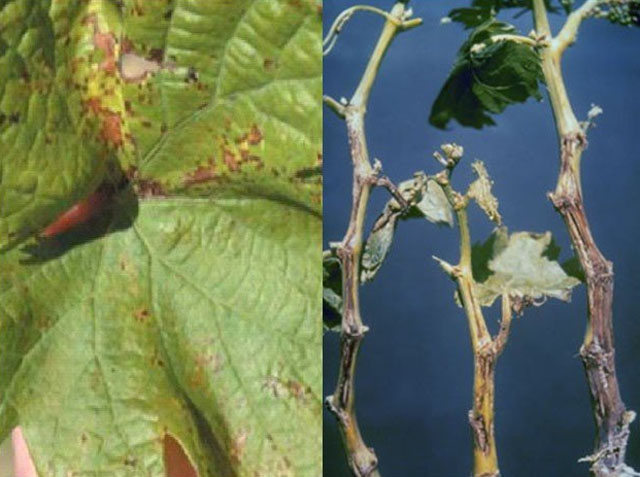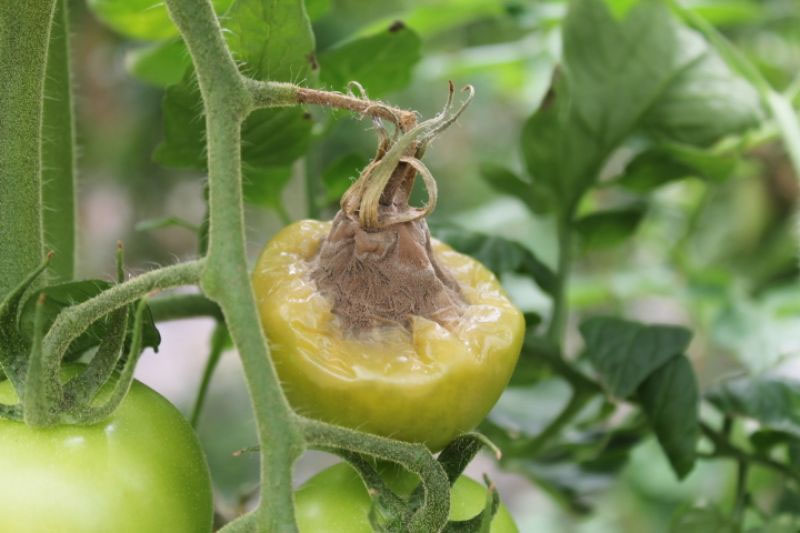Grapevine powdery mildew is a widespread disease of grapevines. In 2009, my vines were destroyed by mildew. In 2010, one year later, the situation is very different. My vines are full of healthy grapes. See what have changed, what I did, and how I did it.
2009 – The destruction of my vines by powdery mildew
In 2009, was the first year that I was de facto forced to deal with the vines that existed on the property. I had no idea and this was evident from the result as you will see in the photos below.
The vines were affected by powdery mildew early on. I didn’t even know what mildew was at the time. By the time I found out what powdery mildew was – around June 2009, it was already too late. No matter what I did, I couldn’t save them. So I just watched the grapes slowly die.
Powdery mildew infestation in a vineyard. 19 June 2009. The characteristic fuzz appeared on the grape berries.
Powdery mildew infestation in a vineyard. 12 July 2009. Note the characteristic fuzz and cracking on the grape berries.
Powdery mildew infestation in a vineyard. On 2 August, mildew has shown its teeth. The bunches die one after the other.
Powdery mildew infestation in a vineyard. On 15 August. The destruction is complete. The affected berries have dried up. The bunches of grapes are completely damaged.
Powdery mildew infestation in a vineyard. In mid-September, some bunches had survived, but their condition was tragic as you can see in the photo.
2010 – I was better prepared to deal with vine powdery mildew
2010 found me better prepared to deal with vine powdery mildew. I knew I was up against a ruthless enemy. Only the right preparation and actions at the right times could help me.
My invaluable ally in this effort was the knowledge I gained from two books.
The book“Viticulture” by Kostas Koussoulas (Agronomist – Viticulture Specialist) and its complementary book “Vine Grower’s Diary” also by Kostas Koussoulas.
In both I found valuable tips and instructions to have healthy vines and a rich harvest.
I may have had some of the beginner’s luck, but the results were amazing as you will see in the photos below.
Note: this is the same vineyard as the one in the previous photos!
Treatment of powdery mildew in a vineyard. 10 June 2010. One year later, the picture of the vine bunches is very different. I have healthy bunches with no signs of powdery mildew.
Treatment of powdery mildew on a vine. 14 July 2010. Grape berries are large and healthy. In the middle of the photo, however, you will see that there is a sample of powdery mildew infestation. This happened because we were just gone for a week on vacation. During that time it rained heavily. But I was not present to take the appropriate measures to deal with the powdery mildew.
Treatment of powdery mildew in a vineyard. 31 July 2010. the vine is nothing like last year’s image. it is full of rich bunches.
Treatment of powdery mildew on a vine. 8 August 2010. The grapes continue to grow without serious problems. So far. Hooray! With powdery mildew you never know until harvest.
Additional information about grapevine powdery mildew can be found at kalliergo.gr under Grapevine Mildew.
Mildew or Thiaphasthenia or Downy Mildew or Bustra or Downy Mildew or Cholera or Lova
(Useful advice to producers-farmers, by Petridis Panagiotis (Agronomist TE))
Powdery mildew is the most serious disease of the vine after botritis. It is widespread in all countries of the world. In Greece it is often known as thiaphasthenia or ash.
This disease affects all the tender organs of the vine (leaves, shoots and grapes). The most common and characteristic symptoms are on the leaves in the form of a light-coloured spot on which a floury coating (like a powder) then develops, particularly on leaves that are in a shaded part of the plant. These spots may extend to cover the whole leaf while at the same time preventing the plant from growing. Very important to note that if the powdery mildew infestation occurs before flowering it causes the flowers to drop. More common, however, is the infestation of grapes that occurs after pollination on the ridge of the brome and on the rails. The areas of infestation are initially covered by rashes and later turn brown. When the affected berries are small they dry up and fall off, while when they are larger they cease to grow normally and are torn at the point of infestation. The torn rails dehydrate and rot. If the infestation of the rails occurs after ‘polishing’ the rails do not split, but show rhizoidal or netted mottling.
Very common is the late infestation of vines, which at first appears in the form of patches of white rash, which later develop into reddish-brown areas with an irregular rooted periphery. These reddish-brown spots can also be seen on the affected clematis after necrosis of the mycelium during the winter period.
The disease is caused by the fungus erysiphe necator with the imperfect form of the fungus Oidium tuckeri, which is carried into the vineyard even by the wind, affecting susceptible plants, and is favored by humidity and warm weather.
The ideal temperature for the growth of the powdery mildew is between 21 and 30 degrees Celsius, while it cannot grow at temperatures above 40 degrees Celsius.
Treatment
In general, the best method of dealing with powdery mildew is prevention. Sulphur is the most effective and economical fungicide if applied proactively and before the appearance of powdery mildew.
It should be noted, however, that if temperatures are below 18 degrees it is best not to use sulphur because it is not effective. The best temperature for sulphur to work is about 25 to 30 degrees Celsius, while sulphur sprays are not recommended at temperatures above 35 degrees Celsius it is advisable when temperatures are high to spray or sulphurize early in the morning.
Other active substances that can be used to control powdery mildew are myclobutanil, penconazole, quinoxyfen.
The treatments are done:
(a) when the shoots have acquired the third leaf and before the flowers appear,
(b) during flowering,
(c) after the rails have been tied; and
(d) every 15 – 20 days until the stage of rail polishing and depending on the intensity of the infestation.
In addition, sulphur preparations are available in forms which are more convenient for producers. (e.g.: sulphur in wet powder or liquid)
Particularly for organic farming, the timely application of sulphur preparations is of great importance. (for any questions please ask your agronomist).
Finally, powdery mildew is a fungus which, with the same symptoms on the leaves, also appears on ornamental plants such as rose bushes. A preventive sulphur treatment will help to limit the disease and in an advanced stage the above mentioned preparations provide the necessary treatment. (it is necessary to always take the necessary protective measures always with the advice of an agronomist).
Tags: CHOLERA • GRAPES • POWDERY MILDEW • SULFUR • VINEYARD













